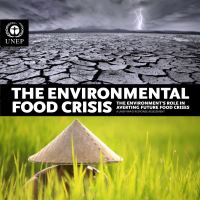

98
GISP (Global Invasive Species Programme) (2008). Invasive Alien Spe-
cies – A Growing Global Threat. Available online at:
http://www.gisp.org/ecology/IAS.asp [Accessed on the 20 January 2009].
GISP (Global Invasive Species Programme). (2006). Invasive Species
and Poverty: Exploring the Links. Available online at:
http://www.gisp.
org/publications/Brochures/invasivesandpoverty.pdf [Accessed on the 20
January 2009].
GRAIN (2008). Seized: The 2008 land grab for food and financial secu-
rity. GRAIN briefing, October 2008.
Green et al. (2005). Sparing land for nature: exploring the potential im-
pact of changes in agricultural yield on the area needed for crop produc-
tion. Global Change Biology 10 (11): 1594-1605.
Groombridge, B. and Jenkins, M.D. (2002). World atlas of biodiversity:
earth’s living resources in the 21st century. University of California Press,
California, USA.
Hanasaki et al. (2008a). An integrated model for the assessment of
global water resources Part 1: Model description and input meteorological
forcing. Hydrology and Earth System Sciences 12 (4): 1007-1025.
Hanasaki et al. (2008b). An integrated model for the assessment of
global water resources Part 2: Applications and assessments. Hydrology
and Earth System Sciences 12 (4): 1027-1037.
Henao, J. and Baanante, C. (2006). Agricultural Production and Soil
Nutrient Mining in Africa. Summary of IFDC Technical Bulletin. IFDC,
Alabama, USA.
Henningsson et al. (2004). The value of resource efficiency in the food
industry: a waste minimization project in East Anglia, UK. Journal of
Cleaner Production 12 (5): 505-512.
HYDE, History Database of the Global Environment, v 3.0,
http://www.
mnp.nl/hyde.
IAASTD (2008). International Assessment of Agricultural Knowledge,
Science and Technology for Development. IAASTD, Washington, D.C.
Available online at:
http://www.agassessment.org/docs/IAASTD_GLOB-AL_SDM_JAN_2008.pdf [Accessed on the 20 January 2009)
ICIMOD (2008). Food Security in the Hindu Kush-Himalayan Region.
ICIMOD, Chengdu.
IFPRI (2006). Annual report 2005-2006. IFPRI, Washington, D.C.
Available online at:
http://www.ifpri.org/pubs/books/ar2005/ar05.pdf[Ac-
cessed on the 20 January 2009].
IFPRI (2007). The World Food Situation: New Driving Forces and Re-
quired Actions. IFPRI, Washington D.C. Available online at:
http://www.
ifpri.org/pubs/fpr/pr18.pdf [Accessed on the 20 January 2009].
IFPRI (2008). The Challenge of Hunger in 2008, Global Hunger Index,
IFPRI, Washington D.C. Available online at:
http://www.ifpri.org/pubs/cp/ghi08.asp#dl [Accessed on the 20 January 2009].
International Fertilizer Association (2008). IFADATA. Available online
at:
http://www.fertilizer.org/ifa/ifadata/search[Accessed on the 20 Janu-
ary 2009].
International Monetary Fund (IMF) (2008). IMF Primary Commod-
ity Prices, monthly data (CSV file) for 8 price indices and 49 actual price
series, 1980 - current. IMF, Washington D.C. Available online at: http://
www.imf.org/external/np/res/commod/index.asp[Accessed on the 20
January 2009].
IPPC (2004). RIO/Uppsala Armed COnflict Dataset. International
Peace Research Institute, Oslo (PRIO), Department of Peace and Conflict
Research, Uppsala University, Stockholm International Peace Research In-
stitute 2003.
IPCC (2007). Climate Change 2007: Impacts, Adaptation and Vulner-
ability. Contribution of Working Group II to the Fourth Assessment Report
of the Intergovernmental Panel on Climate Change. M.L. Parry, O.F. Can-
ziani, J.P. Palutikof, P.J. van der Linden and C.E. Hanson (ed.). Cambridge
University Press, Cambridge, UK.
IUCN (2008). Red list of threatened species. IUCN, Gland, Switzerland.
Available online at:
http://www.iucnredlist.org/[Accessed on the 20 Janu-
ary 2009].
Jianchu, X., A. Shrestha, et al. (2007). The Melting Himalayas: Regional
challenges and local impacts of climate change on mountain ecosystems
and livelihoods. ICIMOD Technical Paper. Katmandu, Nepal, ICIMOD.
Kader, A. A. (2005). Increasing food availability by reducing postharvest
losses of fresh produce. Proceedings of the 5th International Postharvest
Symposium, Mencarelli, F. (Eds.) and Tonutti P. Acta Horticulturae, ISHS.
Kantor et al. (1999). Estimating and addressing America’s food losses.
American Journal of Agricultural Economics 81 (5): 1325-1325
Kenis et al. (2009). Ecological effects of invasive alien insects. Biological
Invasions 11 (1): 21-45.
Keyzer et al. (2005). Diet shifts towards meat and the effects on cereal use:
can we feed the animals in 2030? Ecological Economics 55 (2): 187-202.
Klein, Goldewijk K. (2001). Estimating global land use change over the past
300 years: the HYDE database. Global Biogeochemical Cycles 15 (2): 417- 433.
Klein, Goldewijk K. (2005). Three centuries of global population growth:
A spatial referenced population density database for 1700 – 2000. Popula-
tion and Environment, 26 (4): 343-367.
Klein, Goldewijk K. and Beusen, A. (2009). Long term dynamic model-
ing of global population and built-up area in a spatially explicit way. In
preparation.
Knight, A. and Davis, C. (2007). What a waste! Surplus fresh foods re-
search project, S.C.R.A.T.C.H. Available online at:
http://www.veoliatrust.
org/docs/Surplus_Food_Research.pdf [Accessed on the 20 January 2009].
Kremen, C. and Chaplin-Kramer, R. (2007). Insects as providers of
ecosystem services: crop pollination and pest control. In Insect Conserva-
tion Biology: proceedings of the Royal Entomological Society’s 23rd Sym-
posium. A.J.A. Stewart, T.R. New and O.T. Lewis (ed.). CABI Publishing,
Wallingford.
Lal, R. (1998). Soil erosion impact on agronomic productivity and envi-
ronment quality. Critical reviews in plant sciences 17: 319-464
Le Maitre et al. (2004). Alien plant invasions in South Africa: driving
forces and the human dimension. South African Journal of Science 100
(1), 103–112.
Liu, X.D. and Chen, B.D. (2000). Climatic warming in the Tibetan Pla-
teau during recent decades. International Journal of Climatology 20 (14):
1729-1742.
Lobell et al. (2008). Prioritizing climate change adaptation needs for
food security in 2030. Science 319 (5863): 607-610.
Long et al. (2006). Food for thought: Lower-than-expected crop yield stim-
ulation with rising CO
2
concentrations. Science 312 (5782): 1918-1921.

















